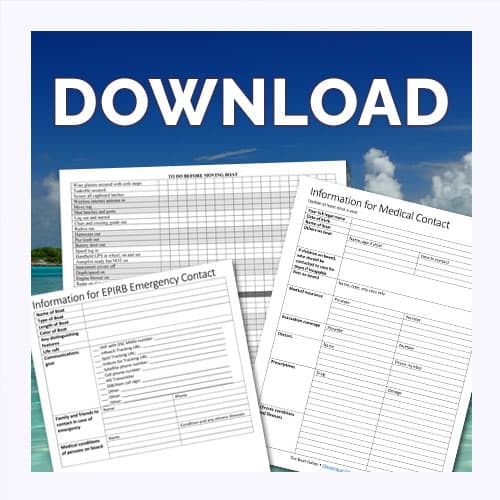With the myriad of so-called safety gear being promoted by manufacturer and sailing magazines, how do you choose what you actually need without sinking your cruising budget? Lin Pardey, who after more than 200,000 miles of voyaging is still heading off across oceans and evaluating offshore gear, shares her thoughts on how to evaluate potential safety gear.
Links (Amazon):
Mustang Inflatable PFD with Harness — hydrostatic so doesn’t inflate in rain or spray
Pardey Offshore Sailing Video Series
Prefer to read? See transcript below.
Can You Buy Safety?
The list of safety gear you “should” buy is endless; the potential to sink your cruising budget by buying it is definitely real. Some safety gear is essential, some is useful, most of it will never get used so where do you draw the line? It’s a hard call even for experienced sailors. The only way to make wise choices is by getting out sailing and racking up lots of sea time in lots of different weather situations so you can truly evaluate what equipment you need. In the rush to ready your boat and shore life so you can get out cruising, it is hard to gain this experience/sea time.
Here are some thoughts to keep in mind when you consider safety gear:
- The first and most important piece of safety gear you have on board is a partner who has the knowledge and skills to handle the boat. There is not one piece of man-overboard gear that is going to help if the person left on the boat does not know how to get the boat back to you.
- Your boat is your life raft. That rubber thing in a valise or canister is an abandon-ship raft, a flimsy replacement for the strong boat you are thinking of leaving and only a hopeful last chance. The vast majority of boats abandoned by their owners are later found drifting crew-less and afloat.[1]
- The harness you may or may not use on deck is just that, a harness to back up your hands. It does not insure safety, nor is it a substitute for learning to move around on deck using the old fashioned sounding seaman’s adage; one hand for you, one hand for the ship.
- The only sure way of avoiding collisions at sea is by having someone stand watch in the cockpit. A watch keeper on deck will be able to spot that violent squall approaching in time to drop sail before it hits. Because he/she will have lots of time to look around the boat the watch keeper might notice a potential gear failure before it causes a serious problem. The more reasons (or excuses) you have for staying below deck, the less safe you become.
- Gear that is used only in emergencies may not function properly if you and the crew have not practiced using it. Inflatable items like liferafts may also fail to inflate/deploy/work due to ingress of salt water, exposure to sun and heat or human error when it was originally packed or repacked.
- Think prevention instead of cure. I.e. improving the non-skid on your deck and cabin-top could prevent crew from skidding overboard. Improving your boomvang/preventer-tackle-system could prevent an injury-causing accidental gybe.
Over the past months I have had the pleasure of rendezvous with some highly experienced cruising sailors, folks who have each circumnavigated twice and sailed far beyond the normal routes including Noel and Litara Barrett winners of the Blue Water Medal, Alvah and Diana Simons, Beth Leonard and Evans Starzinger.
Interestingly the topic of safety brought the same reactions from each of these master sailors, “it’s far safer at sea than on the freeways. Cars whizzing past you at 60 miles an hour, only three or four feet to spare. Out at sea you are rarely moving more than 6 or 8 knots.”
But we all agreed; with experience comes confidence, with confidence comes the ability to access safety or decide what is an acceptable risk. Almost everyone who sets off cruising has far more experience on freeways than at sea.
If you had a look at the boats each of these remarkable people sail you’d be surprised at how Spartan their “safety gear” list appears. Each of their boats is highly geared towards efficient sailing, each has very clear deck areas and an extensive system of handholds throughout the cabin, in the cockpit and on deck, and each has all essential systems independent of electricity. Each carries a plethora of back up rigging and sail repair equipment. Each has an abundance of anchors, anchor-rodes and powerful windlasses.
If you are outfitting for your first foray offshore, consider spending some of the funds you put aside for safety equipment on a learn-to-cruise charter. Invite that salty old guy who sailed around the world ten years back to go out sailing with you for a weekend and assess your gear, or lack of it, through his eyes. Hire a professional delivery skipper to join you for a day or two of sea-trials before you invest in any more “safety” gear. You will be buying something far more dependable than a piece of gear that might theoretically save your life in a theoretical situation; you’ll be buying first-hand experience that could prevent that theoretical catastrophe from happening in the first place.
[1] Cost-Conscious Cruiser has a comparative list of gear including safety equipment, carried by four different long term voyagers sailing on limited budgets.





Cindy Balfour says
Excellent read, thanks for the text option. SV Full Circle, currently cruising Vanuatu.